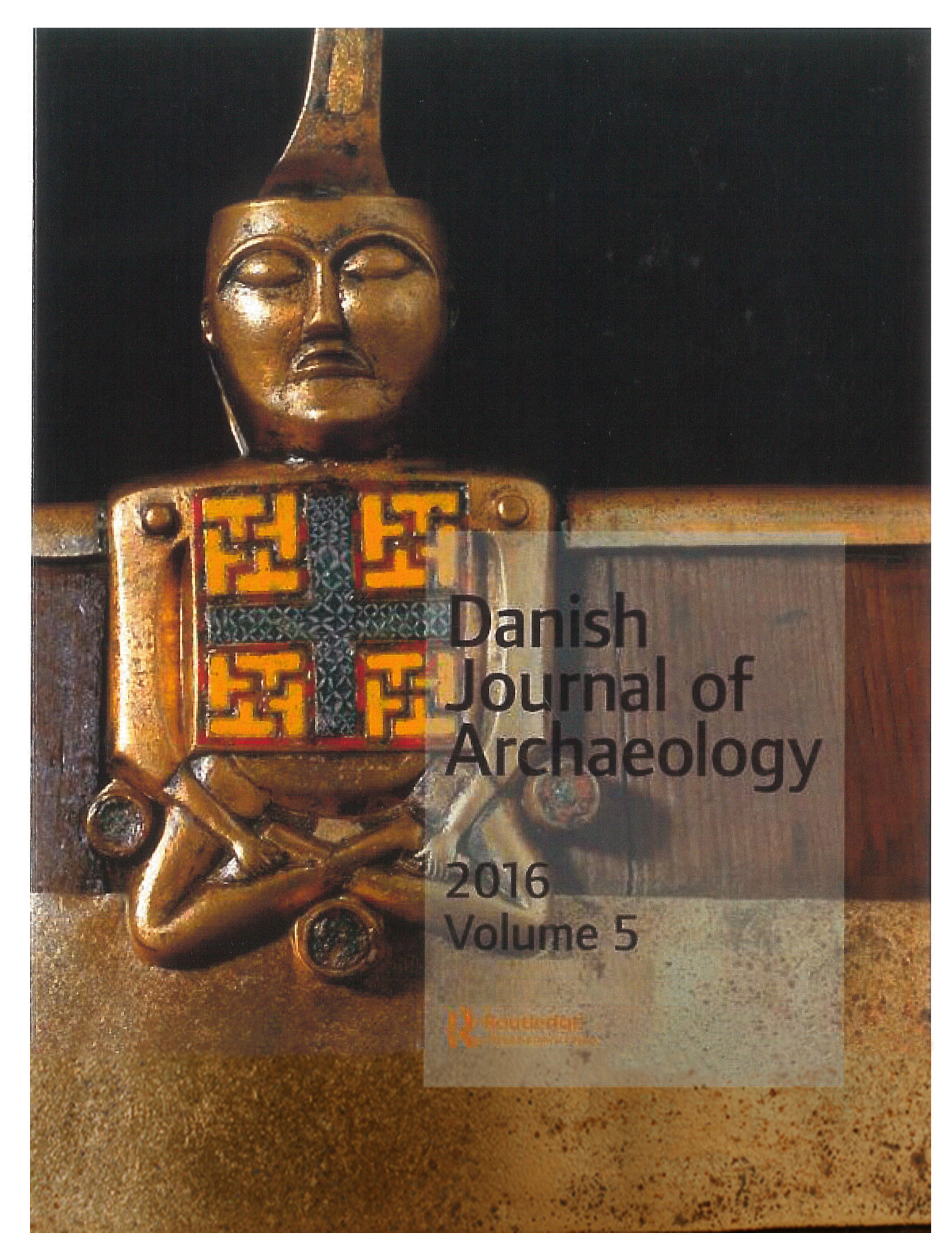The hydrology and preservation condition in the flat-topped burial mound
Klangshøj at Vennebjerg in Vendsyssel
DOI:
https://doi.org/10.1080/21662282.2016.1256099Keywords:
Burial mound, hydrology, borings, Viking AgeAbstract
Klangshøj is a flat-topped burial mound similar to the Royal Jelling mounds, although smaller. The myths tell that a well has existed on top of the mound as at Jelling and a spring had flown at the base of the mound. In order to verify the myths and a similar hydrology in Klangshøj as found in Jelling, several borings have been carried out in a north-south line across the mound.
The investigation showed that Klangshøj is built of sods mainly harvested from heathland. The sods are of different grain sizes from fine sand to clay. The preservation conditions were excellent in three of the six borings, where undecomposed plant remnants, occasionally greenish, were observed. A 14C-dating showed that the mound was built in the Viking Age. The hydrology in Klangshøj is the same as in the Jelling mounds, with a permeable bioturbation zone covering almost impermeable, distinct sod layers. This form a perched groundwater table in the transition zone, which keeps the distinct sod layer below anaerobic, i.e. the preservation conditions extremely favourable. The perched water table drains internally as in the Jelling mounds, and there are no current nor fossil evidence to suggest a spring was ever present at the foot slope, as the local legend suggests. Moreover, it seems unlikely that a well, similar to the one on the Jelling mound, has existed on the top of the north-facing slope, as the amount of water the well would have been able to collect is little.
References
Breuning-Madsen, H. and Holst, M.K., 1998. Recent studies on the formation of iron pans around the Oaken log coffins of the bronze age burial mounds of Denmark. Journal of Archaeological Science, 25, 1103-1110. https://doi.org/10.1006/jasc.1998.0288
Breuning-Madsen, H. and Holst, M.K., 2003. A soil description system for burial mounds - development and application. Danish Journal of Geography, 103 (2), 35-45. https://doi.org/10.1080/00167223.2003.10649490
Breuning-Madsen, H., Holst, M.K., and Henriksen, P.S., 2012, The hydrology in huge burial mounds built of loamy tills - A case study on the genesis of perched water tables and a well in a Viking Age burial mound in Jelling, Denmark. Danish Journal of Geography, 112 (1), 40-51. https://doi.org/10.1080/00167223.2012.707797
Breuning-Madsen, H., Holst, M.K., and Rasmussen, M., 2001. The chemical environment in a burial mound shortly after construction - an archaeological experiment. Journal of Archaeological Science, 28, 691-697. https://doi.org/10.1006/jasc.1999.0570
Breuning-Madsen, H., Nørr, A.H., and Holst, K.A., 1992. Atlas of Denmark. Series I, Vol. 3. The Danish Soil Classification. Copenhagen: The Royal Danish Geografical Society, C.A. Reitzel.
Breuning-Madsen, H., Rønsbo, J., and Holst, M.K., 2000. Comparison of the composition of iron pans in Danish burial mounds with bog iron and spodic material. Catena, 39, 1-9. https://doi.org/10.1016/S0341-8162(99)00083-1
Breuning-Madsen, H., et al., 2013. A comparison of soil organic carbon stocks in Viking Age and modern land use systems in Denmark. Agriculture, Ecosystems & Environment, 174, 49-56. https://doi.org/10.1016/j.agee.2013.05.004
Bronk Ramsey, C., 2013. OxCal 4.2. Available from: http://c14.arch.ox.ac.uk/oxcal [Accessed 18. March 2016].
Day, P.R., 1965. Particle fractionation and particle-size analysis. In: C.A. Black, et al., eds. Methods of Soil Analysis. Agronomy No 9. Madison, Wisconsin: American Society of Agronomy, 545-567. https://doi.org/10.2134/agronmonogr9.1.c43
ELTRA, 1995. CS500 simultaneous carbon/sulphur determinator. Neuss, Germany: ELTRA GmbH.
Henriksen, P.S., 2005. Makrofossilanalyser af bygningstørv fra Skelhøj, en bronzealderhøj ved Kongeåen. København: Nationalmuseet, NNU Rapport nr. 20, 2005, 1-6.
Henriksen, P.S., Jessen, C., and Christensen, C., in press. Landscape and vegetation: pollen and macro fossil analysis of the vegetation in the North and South Mounds. In: A. Pedersen and M.K. Holst, eds. The Jelling Monuments and their Local Setting. PNM. Vol. 20. The National Museum of Denmark, Copenhagen.
Holst, M.K., Breuning-Madsen, H., and Olsson, M., 1998. Soil forming processes in and below a Bronze age burial mound at Lejrskov, Southern Jutland. Danish Journal of Geography, 98, 46-55. https://doi.org/10.1080/00167223.1998.10649410
Krogh, K.J., 1993. Gåden om kong Gorms grav. Herning: Poul Kristensens Forlag.
Lindeberg, P., 1591. Hypotyposis arcium, palatiorum et monumentorum, ab Henr. Ranzovio, pro rege Holsato, conditorum. Typis Jacobi Wolfij, Hamburg. http://www.europeana.eu/portal/record/03486/A16C0B1E85620B950BB95437A8849C3CFC02AF5C.html
Randsborg, K., 1996, The Nordic Bronze Age: chronological dimensions. Acta Archaeologica, 67, 61-72.
Reimer, P.J., et al., 2013. IntCal13 and marine13 radiocarbon age calibration curves 0-50,000 years cal BP. Radiocarbon, 55, 1869-1887. https://doi.org/10.2458/azu_js_rc.55.16947
Downloads
Published
How to Cite
Issue
Section
License
Counting from volume 11 (2022), articles published in DJA are licensed under Attribution-NonCommercial-ShareAlike 4.0 International (CC BY-NC-SA 4.0). The editorial board may accept other Creative Commons licenses for individual articles, if required by funding bodies e.g. the European Research Council. With the publication of volume 11, authors retain copyright to their articles and give DJA the right to the first publication. The authors retain copyright to earlier versions of the articles, such as the submitted and the accepted manuscript.
Articles in volume 1-8 are not licensed under Creative Commons. In these volumes, all rights are reserved to DJA. This implies that readers can download, read, and link to the articles, but they cannot republish the articles. Authors can upload their articles in an institutional repository as a part of a green open access policy.
Articles in volume 9-10 are not licensed under Creative Commons. In these volumes, all rights are reserved to the authors of the articles respectively. This implies that readers can download, read, and link to the articles, but they cannot republish the articles. Authors can upload their articles in an institutional repository.





